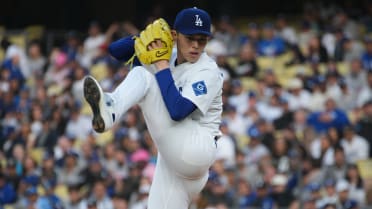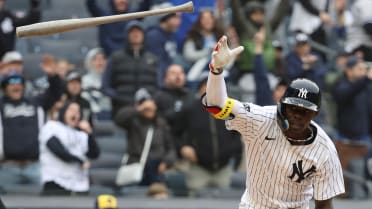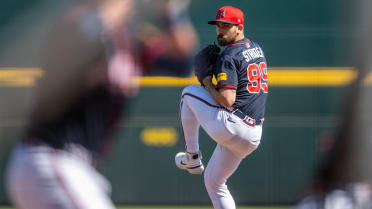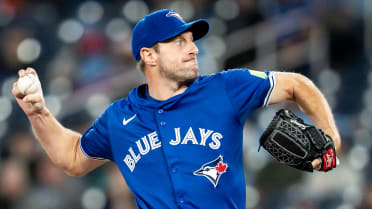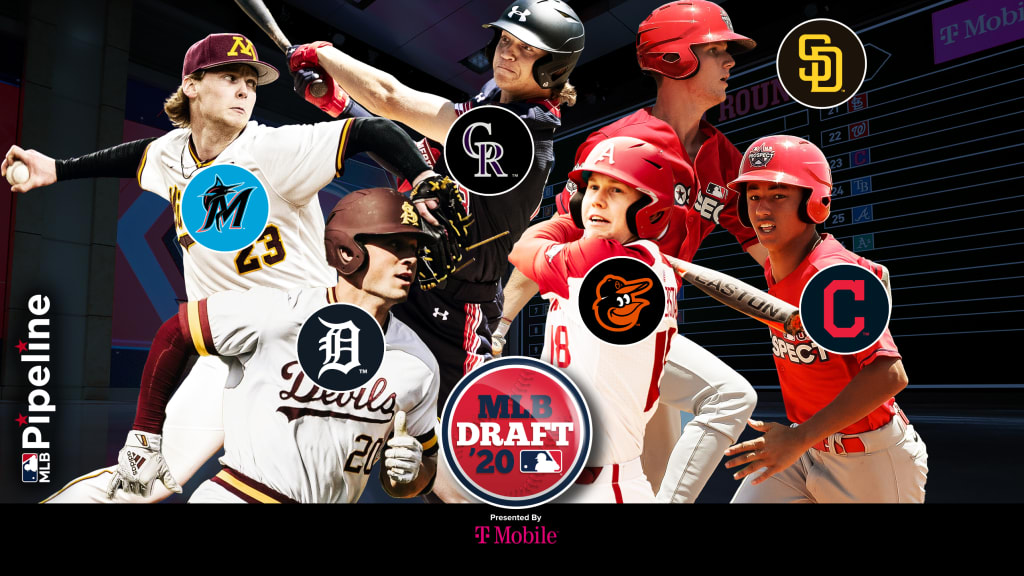
The Tigers may have had baseball's worst record last year, but their farm system provides optimism for their future. They're deeper in prospects than they have been in two decades, especially on the mound, with 2018 No. 1 overall pick Casey Mize, '16 first-rounder Matt Manning and '18 ninth-round steal Tarik Skubal.
With the No. 1 overall choice on Wednesday and five more selections on Thursday, Detroit took six straight position players. Not only did the Tigers add some balance to their system, but they also had the best Draft of any of the 30 clubs.
Here's how we rank the top half-dozen Drafts, based on the assumption that all the players selected will sign pro contracts before the Aug. 1 deadline:
1. Tigers
Detroit kicked things off by taking a transcendent offensive player in Arizona State first baseman Spencer Torkelson and will try to extract more defensive value out of him by giving him a chance at third base. Then the Tigers grabbed four more college bats in Ohio State catcher Dillon Dingler (second round), whose arm strength and athleticism stand out; a pair of steady offensive performers in Louisiana State outfielder Danny Cabrera (supplemental second) and Rice shortstop Trei Cruz (third); and Arizona State third baseman Gage Workman (fourth), a switch-hitter with raw power who's also a gifted defender perhaps capable of shifting to shortstop. They wrapped up their effort with Mississippi high school third baseman/right-hander Colt Keith (fifth), who has a chance to hit for power and average and also features a pair of promising pitches in an 89-93 mph fastball and an upper-70s curveball.
2. Marlins
Miami took the exact opposite approach to Detroit by selecting six straight pitchers, all with intriguing upside. The Marlins started with Minnesota right-hander Max Meyer (No. 3 overall), who pairs the best pitch in the Draft (a wipeout slider) with a fastball that reaches triple digits, and Oklahoma high school left-hander Dax Fulton (second round), the top prep southpaw available and the owner of a projectable 90-93 mph fastball and a nasty curveball. Ball State righty Kyle Nicolas (supplemental second) is one of the hardest-throwing starters (up to 100 mph) in the college ranks, while Coastal Carolina righty Zach McCambley (third) generates high spin rates on his low-90s fastball and power curveball. Vanderbilt lefty Jake Eder (fourth) and Southern California righty Kyle Hurt (fifth) lack consistency but can reach 97 mph with their fastballs and back them up with solid secondary pitches.
3. Rockies
Colorado landed some of the biggest names in the Draft, picking up three of the top 35 players on MLB Pipeline's Draft Top 200: Florida high school outfielder Zac Veen (No. 9 overall), who draws Cody Bellinger and Christian Yelich comps and wasn't supposed to get out of the top five, Texas high schooler Drew Romo (supplemental first round), the best defensive catcher in the Draft, and Miami right-hander Chris McMahon (second), who has a lively 93-98 mph fastball and developing secondary offerings. Clemson left-hander Sam Weatherly (third) can outmatch hitters with a 91-96 mph fastball and a sharp slider. The Rockies believe they uncovered a sleeper in their own backyard in Colorado prep right-hander Case Williams (fourth), while Michigan shortstop Jack Blomgren (fifth) is a glue guy who gets on base and provides steady defense.
4. Orioles
Baltimore seemingly got as much attention for not taking Vanderbilt outfielder/third baseman Austin Martin than it did for choosing Arkansas outfielder Heston Kjerstad at No. 2 overall, which diminishes the fact that Kjerstad possessed the best left-handed power in the Draft and starred in college baseball's best league (the Southeastern Conference) just like Martin did. Saving money with Kjerstad gave the Orioles enough cash to sign two high schoolers at the end of their Draft: Florida third baseman Coby Mayo (fourth round), who offers a lot of raw power and arm strength, and projectable Iowa right-hander Carter Baumler, who could have three solid or better pitches once fully developed. In between, they took three college position players in slugging Mississippi State shortstop Jordan Westburg (supplemental first), potential 20-20 center fielder Hudson Haskin (second) from Tulane and slick-fielding Mississippi shortstop Anthony Servideo (third).
5. Padres
San Diego poured most of its bonus-pool resources into their first four choices and came away with four of the best 75 prospects in the Draft. Tennessee high school outfielder Robert Hassell (No. 8 overall) is the best pure hitter in the prep class, Texas high school right-hander Justin Lange (supplemental first round) hit 100 mph and flashed a plus slider this spring, and prep outfielder Owen Caissie (second) is Canada's version of Veen. Georgia righty Cole Wilcox (third) also tops out at 100 mph and shows the makings of a pair of plus secondary pitches, looming as a possible steal after projecting as a first-rounder. To squeeze Wilcox into their budget, the Padres used their final two picks on deceptive Troy right-hander Levi Thomas (fourth) and projectable North Carolina high school left-hander Jagger Haynes (fifth).
6. Indians
While all of the teams above had one of the first nine picks, Cleveland had a strong Draft even if it had to wait until No. 23. Using that choice on Arizona prep shortstop Carson Tucker (who, like his brother on the Pirates, Cole, plays a solid shortstop and offers offensive upside) and a supplemental first-rounder on Auburn right-hander Tanner Burns (who works with a 92-97 mph fastball and shows signs of a plus breaking ball) positioned the Indians for the best second-day Draft. They got value with each of those selections: polished Florida International left-hander Logan Allen (second round); toolsy California high school outfielder Petey Halpin (third); California prep shortstop Milan Tolentino (fourth), a quality defender and patient hitter; and Vanderbilt right-hander Mason Hickman (fifth), a proven winner whose command helps his average stuff play up.
Honorable mentions
The Blue Jays had the best Draft that didn't feature any extra picks, highlighted by Martin (the Draft's best pure hitter) falling into their laps at No. 5 and Florida State right-hander C.J. Van Eyk (who has a promising fastball/curveball combo and enticing pitch metrics) getting to them in the second round. Among clubs without a full complement of five choices, the Phillies did the best by snagging the top high school pitcher (Mick Abel, out of Jesuit High in Portland, Ore.) at No. 15 and one of the most athletic collegians (Arkansas shortstop Casey Martin) in the third round.
Jim Callis is a reporter for MLB.com. Follow him @jimcallisMLB and @jimcallis.bsky.social. Listen to him on the weekly MLB Pipeline Podcast.

